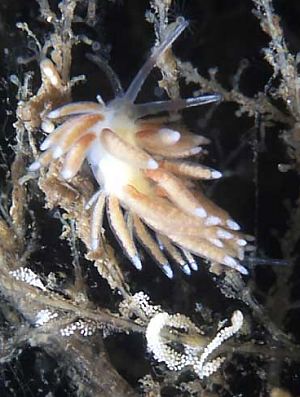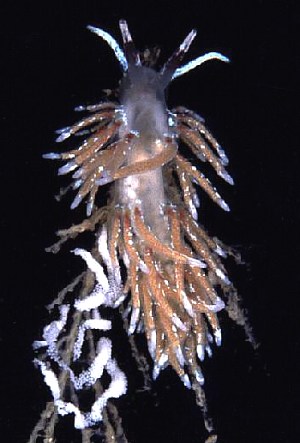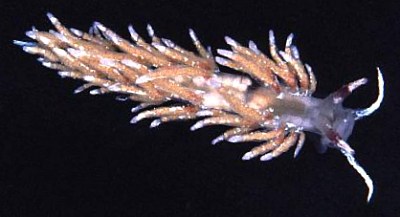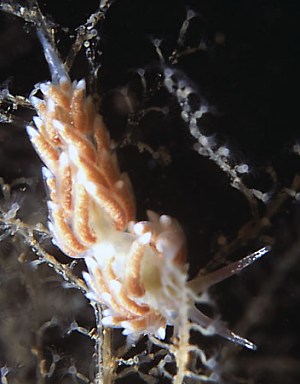
Cuthona rubescens
Picton & Brown, 1978
Order: NUDIBRANCHIA
Suborder: AEOLIDINA
Family: Tergipedidae
DISTRIBUTION
Previously known only from the British Isles, but see message below with records from Holland and Norway
PHOTO
Manse Reef, Loch Leven, west coast of Scotland. 15mm long. 9 June 2002. Photo: Jim Anderson.
Although only easy to see in adults, one of the most characteristic features of this species is that the bases of the cerata are suffused with red. Streaks of white cover the dorsal surface of the cerata and towards the tip the white becomes more concentrated. The upper half of the rhinophores are mostly white and there is a darke reddish band about midway. One other distinguishing feature is that the dorsal surface of the oral tentacles have a continuous band of white . Adults grow to about 18mm in length. It feeds on the common hydroid Halecium halecinum. A very similar looking species, Cuthona amoena, feeds on the same hydroid. It differs in having a brown band in the middle of the oral tentacles.
Reference:
• Picton, B.E. Nudibranchs of the British Isles
• Thompson, T.E. & Brown, G.H. 1984. Biology of Opisthobranch Molluscs, Volume II.
Rudman, W.B., 2002 (June 18) Cuthona rubescens Picton & Brown, 1978. [In] Sea Slug Forum. Australian Museum, Sydney. Available from http://www.seaslugforum.net/find/cuthrube
Related messages
Cuthona rubescens from continental Europe
October 2, 2002
From: Peter H. van Bragt


Hello Bill,
Until recently Cuthona rubescens was only found on a limited number of sites on the western part of the British Isles.
However now we know that it is also present on the continental coast of Europe. In June 1999, Jussi Evertsen found a single specimen in the Trondheim Fjord (Norway). In June 2002 I personally found three specimen on Halecium halecium at the Westbout, Oosterschelde (South-west, the Netherlands). And Marianne Ligthart found in the same month again one specimen at Burghsluis, which is only three kilometers to the east of the first site in the Netherlands. We also found the spawn of this species. I believe that it is not as rare as we might consider it to be at present. Its small size and nondescript anatomy makes it rather cryptic. I am sure most divers just do not recognise it.
Greetings from the Netherlands
Peter H. van Bragt
vanbragt.phjm@hsbrabant.nl
Bragt, P. H., 2002 (Oct 2) Cuthona rubescens from continental Europe. [Message in] Sea Slug Forum. Australian Museum, Sydney. Available from http://www.seaslugforum.net/find/8014Thanks Peter,
This is an interesting find. It's strange to think that new finds like this can still be made in European waters.
Best wishes,
Bill Rudman
Cuthona rubescens from Scotland
June 20, 2002
From: Jim Anderson


Dear Dr. Rudman,
Attached are two images of Cuthona rubescens photographed by me during a recent dive (Thanks again to Dr. Bernard Picton for identification). There were several of these animals among the Halecium halecium with there spawn in depths from 12 - 15 metres
Date: 9 June 2002 [morning dive]
Site: Manse Reef, Loch Leven on the west coast of Scotland.
Water temp: 11 deg C
Size: upper photo=18mm; lower photo=15mm
Jim Anderson
jander4454@aol.com
Anderson, J., 2002 (Jun 20) Cuthona rubescens from Scotland. [Message in] Sea Slug Forum. Australian Museum, Sydney. Available from http://www.seaslugforum.net/find/7294Thanks Jim,
Bill Rudman
